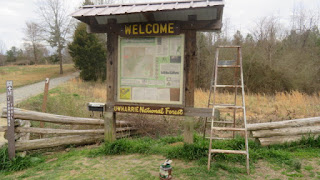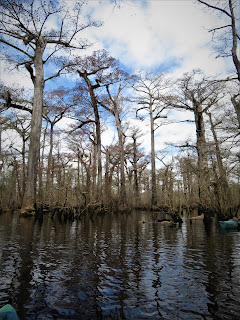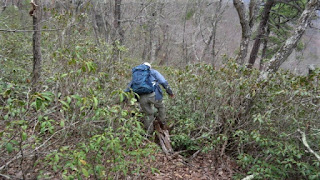
I'm holding a tree core mounted on a piece of wood. The core is from an ancient Bald Cypress - Taxodium distichum. Captain Charles Robbins presents an educational program before we embark on a paddle into the Three Sisters Swamp. The Bald Cypress have been here for a long time. It was not until the 1980s that it became apparent, they should be protected. The Nature Conservancy purchased some land outright and obtained conservation easements on other land. Dr David Stahle from the University of Arkansas, a dendrochronology researcher, was involved at this point but it wasn't until years later that he learned just how ancient these trees were and how extensive the area was. Charles Robbins also was involved early on. He had a long career of adventure and did some of the early exploring in the Three Sisters area. As things unfolded, he saw that the area of ancient Bald Cypress was 10 times the size it was originally thought to be. He guided Dr Stahle through the swamp and they began core dating the trees. The problem was that most of the big trees were hollow. Still alive and thriving but hollow.

They could not get a core sample on a hollow tree. They went around the swamp, knocking on trees and just could not find any big ones to core. Around the campfire one evening, he had an idea. He made a long pole and started banging on trees up higher. Then he fashioned a ladder together so they could climb up a ways to where they could get a solid core. Not all trees were solid up there but some were. Suddenly, the oldest documented trees were older than they imagined. During my 2012 paddle here, the oldest documented tree began growing in 364 AD. Today the oldest documented tree began in 605 BC. It is certain there are older trees but no way exists to document their age.
The core samples do much more than tell how old the tree is. There is a couple thousand years of weather history there. One of the more interesting findings is that in 1587 the drought was the worst in over 800 years. Could that have forced the colonists of the Lost Colony to leave Manteo?
The Nature Conservancy and others have now protected over 16,000 acres here. The Cone family from Greensboro owns a tremendous amount of land on river left. We paddled 12 miles today and every piece of land on our left was Cone property.
After the presentation and shuttle, we shove off into the aptly named Black River. It is windy and a few gusts push us around but we manage to make good headway in the fast moving water.
The first 2 hours of paddling consist of Capt Charles talking almost nonstop. It is a mix of science, tall tales, anecdotes of a life of adventure, sprinkled with some sophomoric humor.
We gather around Charles for a little pep talk before leaving the main body of the river and entering the swamp. The spot we enter is a bit further downriver than where I entered the swamp on two previous trips.
As we enter the swamp, we veer right and pick our way through a maze of trees and knees.
Brown Snake
Charles is quite comfortable in the swamp. He knows where he is all the time. As we float through, he calls out the numerical names of the core dated trees of note. The names all begin with "BLK" followed by a number. Some have a metal tag with that information on it. There is some controversy or mystique involving BLK069. The tree once credited with being the oldest could have had its tag switched or a duplicate made. Something is amiss. That tree was given the name "Methuselah". Personally, I feel that is a bad choice. That is the name of the 4850+ year old Great Basin Bristlecone Pine in California.
The leaves are just budding on the Cypress. We see lots of poison ivy and it is quite convenient to grab it when you need to get through a tight spot. The water is flowing and the wind is blowing. If you want to stop or take a photo, it takes some skill. The best way is to grab a knee and hold on. I ate my lunch with one hand holding on to a knee.
Hollow Tree
Holding on to a knee for lunch
The tops of these trees blew out a long time ago, maybe a 1000 years ago. They grow back and blow out again, giving them this odd appearance.
Oldest documented tree is center, missing its top.
Hollow trees and huge burls are the norm. There is also a phenomenon Charles describes when a tree is in distress, it produces small new branches on its lower main trunk. These branches provide new leaf grown helping the tree photosynthesize, possibly after branches or a top has been blown off.
And what are the knees all about? No one is certain but if you could remove all the water and sand, you would see a network of trees and knees all interconnected as if the trees were clonal. They are not clonal, they are individual organisms but have interconnected, probably for stability. A hurricane might blow out a top but it appears rare that one is uprooted.
This hollow tree was filled with 27 boy scouts according to Charles. I don't think the water level was that high that day. And maybe I heard that number incorrectly. It is a big one and you could get inside and it is a big space inside.
Some new growth branches
We have been in the kayaks since pushing off at Henry's Landing. After lunch, Charles felt we needed a break. He effortlessly guided us to solid ground where we could get out for a few minutes.
After two hours in the swamp, we emerge back into the main channel of the river and begin the final 6 mile paddle out. On three more occasions, Charles takes us back into swamps which provide short cuts from the meandering river. Several of these are also old growth areas. It was impressive to watch the ease at which he knew where to turn and how to emerge from the swamp.
Our paddle concluded after passing under the Rt 53 highway bridge. The rain had just started.





























































